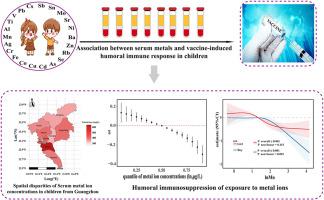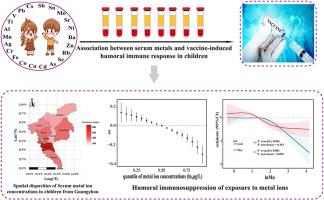在具有性别特异性非线性模式的儿童中,血清金属与抗麻疹、风疹和水痘疫苗抗体水平的关系
IF 7.3
2区 环境科学与生态学
Q1 ENVIRONMENTAL SCIENCES
引用次数: 0
摘要
疫苗接种是公共卫生的基石,可保护个人免受传染病侵害,促进群体免疫,减少疾病传播,并保护弱势群体。尽管人们认识到优化疫苗诱导免疫的重要性,但金属暴露在调节儿童抗体水平方面的作用仍然知之甚少。在这项研究中,我们评估了来自中国广州的1076名3-12岁儿童的血清金属浓度与麻疹、风疹和水痘疫苗抗体水平之间的关系。在对整个儿童的多变量线性回归分析中,钡与所有三种疫苗的抗体水平呈一致的负相关。在性别分层分析中,锡与男女风疹抗体水平呈正相关,而锰与男女风疹抗体水平呈负相关。此外,钡与男女麻疹抗体水平呈负相关。在年龄分层分析中,锌和锡与风疹抗体水平呈正相关,而锰与两个年龄组的风疹抗体水平呈负相关。性别分层限制三次样条分析显示,更多的血清金属与女孩的水痘和风疹抗体水平显著相关,而更多的金属与男孩的麻疹抗体水平相关。具体来说,女孩血清铅和铜与水痘抗体水平呈倒u型关系,而男孩血清铝、锑和铁与麻疹抗体水平呈复杂的非线性关系。此外,锌对两性风疹抗体水平表现出正阈值效应,而钡对水痘和风疹抗体水平表现出u型相关性。金属混合物对风疹抗体水平有综合的负面影响,其中银、锰和铬被确定为主要贡献者。结果显示,环境金属暴露可能影响儿童疫苗诱导的免疫,强调常规血清金属生物监测和潜在的干预措施,以确保最佳的疫苗接种效果。本文章由计算机程序翻译,如有差异,请以英文原文为准。


Associations between serum metals and antibody levels against measles, rubella, and varicella vaccines in children with sex-specific nonlinear patterns
Vaccination is a cornerstone of public health, protecting individuals from infectious diseases, contributing to herd immunity, reducing disease transmission, and safeguarding vulnerable populations. Despite the recognized importance of optimizing vaccine-induced immunity, the role of metal exposure in modulating antibody levels in children remains poorly understood. In this study, we assessed the associations between serum metal concentrations and antibody levels for measles, rubella, and varicella vaccines in 1076 children aged 3–12 years from Guangzhou, China. In multivariable linear regression analyses of the whole children, barium exhibited consistent negative associations with antibody levels for all three vaccines. In sex-stratified analyses, tin showed positive associations, whereas manganese showed negative associations with rubella antibody levels in both sexes. Additionally, barium was negatively associated with measles antibody levels in both sexes. In age-stratified analyses, zinc and tin were positively associated with rubella antibody levels, while manganese was negatively associated with rubella antibody levels in both age groups. Sex-stratified restricted cubic spline analyses revealed that a greater number of serum metals were significantly associated with varicella and rubella antibody levels in girls, whereas more metals were associated with measles antibody levels in boys. Specifically, serum lead and copper exhibited inverted U-shaped relationships with varicella antibody levels in girls, whereas aluminum, antimony, and iron showed complex nonlinear patterns with measles antibody levels in boys. Additionally, zinc demonstrated a positive threshold effect on rubella antibody levels in both sexes, whereas barium exhibited U-shaped associations with varicella and rubella antibody levels. There was a combined negative effect of metal mixtures on rubella antibody levels, with silver, manganese, and chromium identified as the main contributors. The results revealed that environmental metal exposure may influence vaccine-induced immunity in children, highlighting routine serum metal biomonitoring and potential interventions to ensure optimal vaccination effectiveness.
求助全文
通过发布文献求助,成功后即可免费获取论文全文。
去求助
来源期刊

Environmental Pollution
环境科学-环境科学
CiteScore
16.00
自引率
6.70%
发文量
2082
审稿时长
2.9 months
期刊介绍:
Environmental Pollution is an international peer-reviewed journal that publishes high-quality research papers and review articles covering all aspects of environmental pollution and its impacts on ecosystems and human health.
Subject areas include, but are not limited to:
• Sources and occurrences of pollutants that are clearly defined and measured in environmental compartments, food and food-related items, and human bodies;
• Interlinks between contaminant exposure and biological, ecological, and human health effects, including those of climate change;
• Contaminants of emerging concerns (including but not limited to antibiotic resistant microorganisms or genes, microplastics/nanoplastics, electronic wastes, light, and noise) and/or their biological, ecological, or human health effects;
• Laboratory and field studies on the remediation/mitigation of environmental pollution via new techniques and with clear links to biological, ecological, or human health effects;
• Modeling of pollution processes, patterns, or trends that is of clear environmental and/or human health interest;
• New techniques that measure and examine environmental occurrences, transport, behavior, and effects of pollutants within the environment or the laboratory, provided that they can be clearly used to address problems within regional or global environmental compartments.
 求助内容:
求助内容: 应助结果提醒方式:
应助结果提醒方式:


